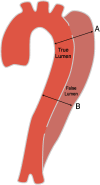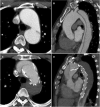Long-Term Outcomes of Chronic Type B Aortic Dissection Treated by Thoracic Endovascular Aortic Repair
- PMID: 36382952
- PMCID: PMC9973582
- DOI: 10.1161/JAHA.122.026914
Long-Term Outcomes of Chronic Type B Aortic Dissection Treated by Thoracic Endovascular Aortic Repair
Abstract
Background The treatment of chronic type B aortic dissection by thoracic endovascular aortic repair has some challenges, and its long-term outcomes remain unclear. This study aimed to analyze the 5-year clinical outcomes of thoracic endovascular aortic repair of chronic type B aortic dissection, compare the differences between patients with and without adverse aortic events (AAEs), and identify risk factors for AAEs. Methods and Results Patients who underwent thoracic endovascular aortic repair of chronic type B aortic dissection from January 2009 to June 2017 were retrospectively enrolled. The primary end points were AAEs, including aorta-related death, procedural complications, and disease progression requiring reintervention. Clinical outcomes were described at the 5-year follow-up visit. The secondary end point was the comparison of the results between patients with and without AAEs. Univariable and multivariable logistic analyses were used to identify potential risk factors for AAEs. A total of 214 patients were enrolled. AAEs occurred in 46 (21.5%) patients. Compared with patients without AAEs, those with AAEs had higher rates of residual type A aortic dissection (26.1% versus 4.2%, P<0.001) and aortic diameter ≥5.5 cm (69.6% versus 11.3%, P<0.001), and a lower rate of complete false lumen thrombosis (23.9% versus 89.9%, P<0.001). Meanwhile, the median interval from symptom onset to intervention was longer in patients with AAEs (26 months versus 12 months, P=0.004). Partial or no false lumen thrombosis (adjusted odds ratio [AOR], 14.71 [95% CI, 5.67-38.14; P<0.001]) and aortic diameter ≥5.5 cm (AOR, 10.16 [95% CI, 3.86-26.73; P<0.001]) were identified as independent risk factors for AAEs. Conclusions While thoracic endovascular aortic repair of chronic type B aortic dissection might be challenging in some cases, its long-term outcomes appeared promising as this treatment was effective in preventing catastrophic aortic events. Patients with AAEs showed higher rates of residual type A aortic dissection and aortic diameter ≥5.5 cm, a lower rate of complete false lumen thrombosis, and a longer median interval from symptom onset to intervention. Failure of complete false lumen thrombosis and an aortic diameter ≥5.5 cm were predictors of AAEs.
Keywords: aortic remodeling; chronic type B aortic dissection; long‐term outcomes; thoracic endovascular aortic repair.
Figures





References
-
- Erbel R, Aboyans V, Boileau C, Bossone E, Bartolomeo RD, Eggebrecht H, Evangelista A, Falk V, Frank H, Gaemperli O, et al. 2014 ESC guidelines on the diagnosis and treatment of aortic diseases: document covering acute and chronic aortic diseases of the thoracic and abdominal aorta of the adult. The task force for the diagnosis and treatment of aortic diseases of the European Society of Cardiology (ESC). Eur Heart J. 2014;35:2873–2926. - PubMed
-
- Winnerkvist A, Lockowandt U, Rasmussen E, Radegran K. A prospective study of medically treated acute type B aortic dissection. Eur J Vasc Endovasc Surg. 2006;32:349–355. - PubMed
-
- Marui A, Mochizuki T, Mitsui N, Koyama T, Kimura F, Horibe M. Toward the best treatment for uncomplicated patients with type B acute aortic dissection: a consideration for sound surgical indication. Circulation. 1999;100:II275–II280. - PubMed
Publication types
MeSH terms
LinkOut - more resources
Full Text Sources
Medical

